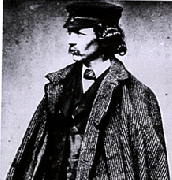Frederic Law Olmsted
 Frederick Law Olmsted
Frederick Law Olmsted
|
"Frederick Law Olmsted (1822 - 1903) was born in Hartford, Connecticut. He was raised as a gentleman, and while he never fully attended college, he did become a very learned man. When he was 18, Olmsted moved to New York to begin a career as a scientific farmer. Soon after that career failed to take off, he toured Europe with his brother, served as a merchant seaman, and traveled throughout the southern United States as a newspaper correspondent, publishing several books as an outgrowth of that career. Through several connections gained as a columnist with the New Yorker, Olmsted was able to gain the appointed as the Superintendent of Central Park, New York City, in 1857, early in the development of that park project. He soon met Calvert Vaux, who had been working on a design for the park with Andrew Jackson Downing. When Downing died, Vaux approached OImsted about collaborating on the project. Their plan, titled Greensward, was ultimately selected as the winning design. In 1859, Olmsted married the widow of his brother, John, and he adopted her children. In 1861, Olmsted obtained a leave of absence from his duties at Central Park so that he could serve as the Executive Secretary (the head of administration) of United States Sanitary Commission, an early version of the Red Cross, which was responsible for aiding the well-being of the soldiers of the Union Army during the Civil War. In 1863, he was offered the position manager at the Mariposa Estate in California, a gold mining venture north of San Francisco, and he left the organization. He later returned to New York when the project failed, joining Vaux in designing Prospect Park (1865-1873), Chicago's Riverside subdivision, Buffalo's park system (1868-1876), and the Niagara Reservation at Niagara Falls (1887). In 1883, he departed New York City and relocated to Brookline, Massachusetts with his practice. Olmsted had begun work on a park system for the City of Boston, eventually he focused much of his time on the Emerald Necklace. This along with his work on the design of the 1893 World's Fair in Chicago were among the last of Olmsted's projects. In 1895, due to failing health Olmsted turned the firm over to his partners, and soon senility forced him to be confined in the McLean Hospital at Waverly, Massachusetts. Ironically, Olmsted had designed the grounds of the institution. Frederick Law Olmsted died on August 28, 1903. The landscape architecture firm he founded was continued by his sons and their successors until 1980. Subsequently, his home and office were purchased by the National Park Service and opened to the public as museum. His papers are now housed in the Library of Congress, while the Olmsted National Historic site preserves the drawings and plans for much of Olmsted and his firm's body of work." (text and photo from Christopher Glynn Parker)
Links:

